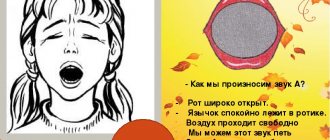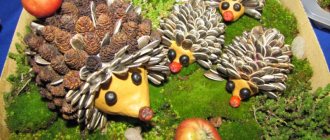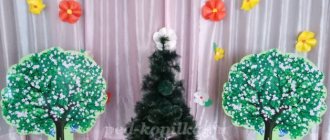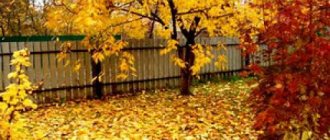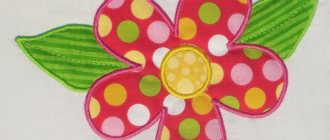Lesson summary for senior preschool children with technical skills “Trees in Autumn”
Target:
- clarify and expand children’s knowledge on the topic “Trees in Autumn”; expand and activate children's vocabulary on this topic.
Correctional educational tasks:
— consolidate the skills of word formation and inflection: agreement of nouns with adjectives; nouns with verbs; select adjectives for nouns;
- develop coherent speech; strengthen the ability to answer questions in complete sentences.
Correction and development tasks:
- development of general and fine motor skills of the fingers with the help of self-massage, su-jok therapy;
- development of visual-spatial perception and speech breathing;
- development of memory and thinking.
Correctional and educational tasks:
- to instill in children a sense of love and respect for nature, to teach correct behavior in nature.
Equipment and materials: pictures of trees, pictures of signs of autumn, tree stump, su-jok balls, story diagram.
Progress of the lesson.
I. Organizational moment: (a toy “Hedgehog” sits on the table)
Speech therapist: Guys, look who came to visit us? Children: Hedgehog! Speech therapist: let's say hello to the hedgehog. What kind of lump is this (clench fists) Waddles between the hummocks? (fiddle with fingers) He carries a lump (clench his fists) Two leaves and a mushroom. (unclench his fingers to the sides) Speech therapist: What did the hedgehog bring on his needles? Let's try to guess? Children: Tree leaves. Speech therapist: Let's thank the hedgehog and warm the little balls in our hands that look so much like hedgehogs. (Su-jok)
II. Main part.
Speech therapist: Guys, look. Here are pictures of trees. Let's list the changes that occur to trees in the fall (leaves turn yellow and fall off). Speech therapist: Well done, you are very observant.
Speech therapist: Now let’s show the hedgehog some fun gymnastics for our tongue (Articulation gymnastics “The Story of a Fun Hedgehog”). Autumn has come in the forest and the clouds have almost covered the sun (exercise “Swing”). It began to rain a little, which quickly ended (exercise “Horse”). The hedgehog looked out the window, looked to the right, looked to the left (exercise “Watch”) - the weather was wonderful. He dressed warmly and went into the forest. The hedgehog walked slowly along the path and heard a woodcutter cutting down an old tree “D-d-d.” The path led the hedgehog to a wonderful clearing (exercise “Shovel”). The hedgehog sat down on a tree stump (exercise “Mushroom”) and looked around (exercise “Watch”). The trees became so beautiful and colorful that the hedgehog fell in love and opened his mouth in surprise (exercise “Window”). Soon, there were even more clouds and they again hid the sun (exercise “Swing”). The hedgehog hurried home.
Speech therapist: Guys, the hedgehog decided to find out what names of trees you know? (exercise with a ball). He also wants to know the parts of trees (roots, trunk, stem, leaves, fruits, seeds, berries, clusters, earrings, bark, cones, crown). Do you know the difference between a tree and a bush? What shrubs do you know? (rose hips, currants, raspberries) Speech therapist: Let's depict an autumn tree (physical minute) We raised our hands and shook them - These are trees in the forest. Arms bent, hands shook. The wind knocks down the dew. Let's wave our arms to the sides smoothly. The birds are flying towards us. We'll also show them when they land. The wings are folded back.
Speech therapist: Guys, the hedgehog really likes to collect herbariums from leaves. Let's help him with this. Here are some oak leaves that fell, which leaf fell? (oak) A maple leaf fell. Which leaf fell? (maple) A birch leaf fell. Which leaf fell? (birch) Well done guys! It turned out to be a wonderful herbarium! Speech therapist: Our hedgehog, sitting in the clearing, likes to come up with interesting stories. Want to listen to one of them?
Su-Jok therapy “The Tale of the Hedgehog”
In a fairy-tale forest, in a small cozy house, there lived a little Hedgehog. Show the ball in an open palm. The hedgehog was small and therefore afraid of everything. He either looked out of his house or hid.
Squeeze and unclench your palm with the Su-Jok ball several times
One early autumn morning the Hedgehog wanted to take a walk. He came out of his house, looked around and ran along the path with his little legs. The path was narrow and winding.
Roll the ball back and forth across your palm.
The Hedgehog ran for a long time. And suddenly he found himself near a large raging river. And a thin bridge was thrown across the river.
Circular movements of the ball in the palm of your hand - first clockwise, then counterclockwise.
He carefully stepped with his small feet onto the narrow bridge - took one step, then a second, third, fourth, fifth - and crossed to the other side!
Roll the ball over each finger, starting with the thumb.
And there is a clearing - big, round, beautiful!
Circular movements of the ball in the palm of your hand.
In the clearing, apparently and invisibly multi-colored leaves were probably blown away by the wind! Beautiful, like in a fairy tale! The hedgehog really liked the clearing, he walked around it, stepped onto the bridge - one step, two, three, four. The fifth... and he's on the other side!
Roll the ball over each finger, starting with the thumb.
The Hedgehog ran quickly - first along a winding path, then in a straight line and ended up at his house!
Roll the ball back and forth across your palm.
Evening came, Hedgehog closed his house, went to bed and fell into a sweet sleep! Hold the ball in your palm. Speech therapist: Guys, the hedgehog told you his story. Let's show the hedgehog how we can write stories? (Children make up a story according to the diagram). Speech therapist: Our lesson has come to an end. What did we talk about today? Let's say goodbye to the hedgehog! Well done, you did a great job.
Author of the material: Bastrakova Elena Aleksandrovna
Also on topic:
Summary of an open lesson in a preparatory speech therapy group
Summary of the GCD “How trees prepare for winter”
- October 22, 2015
Competition “My Pedagogical Initiative - 2015”
Nomination “Methodological work in preschool educational institutions”
Topic of the lesson: “How trees prepare for winter” (using the ecological fairy tale “Girl-Autumn”).
Educational objectives:
- Consolidating children's knowledge about the signs of autumn.
- Formation of a system of knowledge about plant life in the autumn period: understanding the patterns of natural phenomena, the cyclical nature of changes in nature; concretizing children's ideas about the autumn colors of trees.
Developmental tasks:
- Development of analytical abilities: the ability to compare, analyze and establish cause-and-effect relationships and draw conclusions.
- Development of imagination, creative abilities of children, emotional sphere through play-dramatization.
- Development of figurative and demonstrative speech in children.
Educational tasks:
- Fostering in children a careful and caring attitude towards the plant world (trees) as living beings; feelings of importance and necessity of everything that happens in nature.
Materials and equipment for the lesson:
1. Tape recorder, audio recording: P.I. Tchaikovsky "Autumn" from the cycle "Seasons". 2. Autumn leaves from different trees. 3. Leaves made of colored paper (green on one side, red, yellow, brown, etc. on the other) 4. Drape and plumes for rain. 5. Wind mask and scarf. You can purchase pencils, paints, plasticine and other stationery for classes on the website www.kanc-magazin.ru
Preliminary work
Cognitive development:
1) Topic: “Nature on the territory of the kindergarten.” Objectives: To introduce children to the nature of their immediate environment, to teach them to distinguish parts of a plant, to form ideas about the connections of plants and animals with each other and with inanimate nature, to develop educational games; - 2) Topic: “Nature in the city.” Objectives: To introduce children to the nature of their immediate environment, to develop the ability to establish cause-and-effect relationships (plants and their habitat conditions). 3) Topic: “How to help nature in the city.” Objectives: To form initial ideas about environmentally conscious behavior, to help in understanding the connection between people’s behavior and the state of their environment. 4) Topic: “Who eats what.” Objectives: To form ideas about the diversity of fruits and seeds; their roles in human life; about the relationship between plants and animals. 5) Topic: “What are seeds for?” Objectives: To form ideas about fruits, their diversity and purpose, to arouse interest in research activities. 6) Topic: “Poets and writers about autumn.” 7) Theme: “Autumn is on the threshold” (based on the story by N. Sladkov; “Autumn is on the threshold”).
Productive activities.
A) Application: “Colored flowerbed”, “autumn still life”, “leaves on the window”, “gifts of autumn”. B) Modeling: Dancing leaves" (decorative, relief), "Rowan branch", "Apples" C) Drawing: "Trees in our city", "Riddles from the garden", "Autumn colors, autumn leaves" D) Construction: " Friends are pretenders" (natural material)
Didactic games:
1. “Nature and man” (the ability to distinguish between nature and non-nature.) 2. “Recognize a leaf” 3. “Find a leaf, like on a tree” (teach children to classify plants according to a certain characteristic; find a part from the whole) 4. “Wonderful bag" (to consolidate the ability to distinguish and name fruits and vegetables; highlight their characteristic features). 5. “Forest School” (consolidating children’s knowledge about forest gifts). 6. Nature “One, two, three - run to the tree” (to consolidate children’s knowledge about trees). 7. “Children on the branches”
Work outside of class:
- Examination of paintings: I. Grabar “Autumn Leaves”; K. Korovin “Autumn” Examination of illustrations depicting an autumn landscape, insects, birds, animals.
- Solving riddles on the topic: “What autumn has brought us.”
- Reading and viewing (illustrations) of books: A. Vakhrushev “World and Man”, A. Pleshakov “Green Pages”. Learning poems; K. Balmont “Autumn”, L. Divorce “Mischiefs”
Observations:
- Changes in illumination during the day;
- temperature change;
- slowing down plant growth;
- distinguishing trees, shrubs, grasses by trunks, branches, remains of fruits, leaves;
- disappearance of insects (finding places of accumulation);
- departure of insects and birds.
Progress of the lesson
1. Introductory part. Conversation about autumn.
Educator: Guys, guests came to our lesson today. Let's say hello to them. (Children say hello, go to the chairs, and sit down).
- Guys, I suggest you listen to music. (The musical excerpt “Autumn” by P.I. Tchaikovsky from the work “The Seasons” is played).
- Children, what time of year did this piece of music remind you of? Why? (Autumn, nature is sad, summer has gone, etc.)
- What time of year is it now? (Children's statements).
- Or maybe spring? (Children prove that it’s autumn outside. Signs of autumn).
Educator: One of the brightest and most noticeable signs of autumn is yellow strands in the foliage. Guys, which tree starts to turn yellow first? People have a lot of sayings about this. Who wants to tell? Expressions of children (“The linden tree blinked with a variegated leaf - autumn called”).
Educator: Well done, guys! They say there are two autumns? What are their names? (Children's statements: (early autumn or golden; the other - late).
Educator: Yes, children, one joyful autumn, lushly decorated with flowers, foliage, rich in harvest. The other is unsightly, covered in rags of falling leaves, sad with the quiet cry of rain, with heavy clouds in the sky. Guys, let's try to find a lot of definition words for the first golden autumn. (Children select definitions - beautiful, golden, colorful, luxurious, generous, rich in harvest, cheerful, bright, cool, etc.)
Educator: Listen to how beautifully the poet Tyutchev wrote about this nature:
There is a short but wonderful time in the original autumn. The whole day is as if it were crystal, And the evenings are radiant.
Educator: Guys, what words can you choose to describe late autumn? (Children's answers: cold, rainy, wet, crying, sad).
Educator: Well done! Guys, I offer you the game “Good - Bad”. Autumn is good because...(children's answers). This wonderful, fabulous autumn will bring both joy and sadness. And that's probably a good thing.
2. Main part. Magic transformations
Educator: Guys, do you know any fairy tales about autumn? About nature? (Children's answers). Remember the fairy tale “Autumn Girl”, which I came up with with the guys? (Children's answer). Do you want to become the heroes of this fairy tale? (Children: Yes!) Choose who you will be! (Distribution of roles).
Educator: One, two, three - sound the music, lead us into a fairy tale...
There lived a girl. Her name was autumn. She was a kind girl. The Autumn Girl made sure that there was order in her kingdom. And in this kingdom beautiful trees grew. And they all wore green dresses. The Autumn Girl decided to change her green dresses.
Autumn Girl: I will give you a colorful, bright outfit: golden, crimson, purple. And you, the Christmas tree, remain in this unusual, needle-green dress. I really like it.
Educator: It became so beautiful! The Autumn Girl was pleased with herself. She gave the trees bright, colorful dresses, and in return they gave her their smiles. And the Autumn Girl listened to the breeze whispering with the curly birch tree. She admired the hardworking rain, which more and more often washed every leaf in her kingdom. But then one day the trees became sad among themselves.
– I have the most beautiful dress: golden, shiny! - Berezka spoke.
– And I have red, beautiful! – Osinka interrupted her.
And there was such a noise! The Autumn Girl did not like this. She decided to show the debaters and asked her friend:
Autumn Girl: Wind! Wind! Rip off their beautiful, colorful dresses!
Educator: With noise and whistling, he flew into the trees. The leaves trembled. The Wind began to tear off their clothes, tear them and throw them down. The entire earth was covered with a bright carpet. And the trees remained bare. Only El was in her green dress, because she did not participate in the argument. The trees felt ashamed of their actions. And they began to ask the Autumn Girl:
Trees: Autumn Girl, please forgive us. Give us back beautiful, colorful dresses.
Autumn Girl: No! Will not forgive! I love my kingdom and the order in it.
Educator: Soon the Autumn Girl took pity on them.
Autumn Girl: Okay! I will delight you with a colorful outfit only for a few months a year. Then the Wind will blow it away.
Educator: And this was repeated every year...
3. Ecological conversation
Educator: The fairy tale is over. One, two, three - come out of the fairy tale. So we returned to kindergarten again. Guys, does this happen in nature? What is happening in nature with trees now? (Children's statement). Guys, is the fairy tale true? (Children's statements).
Educator: Guys, do you know why trees shed their leaves in the fall? (Children's statement).
Educator: In autumn, the leaves lack sunlight and warm air. They change color and fade. In the place where the petiole sits on the branch (the teacher shows the branch), a flabby belt is formed - the leaf, even in calm weather, comes off and falls to the ground. And when strong winds begin to blow, they tear the luxurious outfit from the trees. This phenomenon is called?... (Leaf fall). This is how trees and shrubs prepare for winter. In winter, trees “sleep” and food and water do not flow from the ground to the leaves. In addition, if snow lingered on the leaves, the branches could break off. (While showing a branch with leaves, the teacher draws the children’s attention to the fact that the branch was picked up from the ground, and not a tree branch was broken).
Educator: Guys, I would like to ask you another question: “Did the Autumn Girl do the right thing?” (Children's statement).
Educator: Guys, would you like to draw the heroes of this fairy tale? (The teacher thanks the children and everyone goes to draw. Music plays).
Follow-up work
1. Topic: “Tree-house and dining room for animals.” Objectives: To form primary ideas about the diversity of plants, their structure, and the relationships of trees with other plants and animals.
2. Topic: “Forest House”. Objectives: To form primary ideas about the forest as a community of living organisms interconnected, about the diversity of forests and the need for their protection, about the rules of behavior while staying in the forest.
3. Topic: “Christmas tree - green needle.”
Author: Uskova Anna Evgenievna, teacher of the compensating group of the Moscow State Administrative Institution, combined kindergarten No. 390, Nizhny Novgorod.
